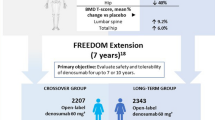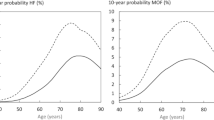Abstract
The aim of the study was to compare the effects of once-weekly alendronate sodium and daily risedronate sodium treatment on bone mineral density (BMD) and bone turnover markers in postmenopausal osteoporotic subjects. For this purpose, 50 patients were included in this study and randomly classified into two groups. Group I (n=25) received risedronate (5 mg/day) and group II (n=25) received alendronate Na (70 mg/week). The study duration was limited to 12 months. The efficacy of the treatment was evaluated by BMD measurements at spine and hip at 6th and 12th months of the treatment, as well as by the measurement of bone turnover markers such as serum osteocalcin (OC), bone-specific alkaline phosphatase (BASP), urine deoxypyridinoline (DPD) and calcium/creatine ratio in 24-h urine at 1st, 3rd, 6th and 12th months. The evaluation of the changes in BMD in all regions revealed a significant increase in BMD in both groups compared to baseline values except for spine (L2–L4) in alendronate group at 6th and 12th month and femoral neck in risedronate group at 6th month. However, the difference in percentage increase in BMD measurements was not statistically significant between the two groups at 6th and 12th months. In both groups, serum OC, BSAP and urine DPD were found to be significantly attenuated at 1st month of the treatment period, and continued to be lowered throughout the 3rd, 6th and 12th months (P<0.05). However, there was no statistically-significant difference between both groups of patients (P>0.05). In conclusion, our results suggest that both treatment protocols provide treatment options of similar efficiencyfor postmenopausal osteoporosis, and have almost-similar effects in enhancing the BMD and in slowing the bone turnover. Risedronate seems to havea more potent effect in the spinal region than that of alendronate, although this potency was not statistically significant.

Similar content being viewed by others
References
Consensus development conference: prophylaxis and treatment of osteoporosis (1991) Osteoporos Int 1:114–117
Garrett-Connor E (1995) The economic and human costs of osteoporotic fracture. Am J Med 98:3–8
Ammann P, Rizzoli R (2003) Bone strength and its determinants. Osteoporos Int 14(suppl 3):13–18
Akesson K (2003) New approaches to pharmacological treatment of osteoporosis. Bull World Health Organ 81:657–664
Cohen SB (2004) An update on bisphosphonates. Curr Rheumatol Rep 6:59–65
Cummings SR, Karpf DB, Harris F, Genant HK, Ensrud K, LaCroix AZ, Black DM (2002) Improvement in spine bone density and reduction in risk of vertebral fractures during treatment with antiresorptive drugs. Am J Med 112:281–289
Yates J, Rodan GA (1998) Alendronate and osteoporosis. Drug Dis Today 3:69–78
McClung M, Bensen W, Bologne M (1996) Risedronate treatment of postmenopausal women with low bone mass: preliminary data. Osteoporos Int 6(suppl I):256
Clemmesen B, Ravn P, Zegels B,Taquet AN, Christiansen C, Reginster JY (1997) A 2-year phase II study with 1-year of follow-up of risedronate (NE-58095) in postmenopausal osteoporosis. Osteoporos Int 7:488–495
Reginster J, Minne HW, Sorensen OH, Hooper M, Roux C, Brandi ML, Lund B, Ethgen D, Pack S, Roumagnac I, Eastell R (2000) Randomized trial of the effects of risedronate on vertebral fractures in women with established postmenopausal osteoporosis. Vertebral efficacy with risedronate therapy (VERT) study group. Osteoporos Int 11:83–89
Harris ST, Watts NB, Genant HK, McKeever CD, Hangartner T, Keller M, Chesnut CH, Brown J, Eriksen EF, Hoseyni MS, Axelrod DW, Miller PD (1999) Effects of risedronate treatment on vertebral and nonvertebral fractures in women with postmenopausal osteoporosis.: a randomized control trial. Vertebral efficacy with Risedronate therapy (VERT) study group. JAMA 282:1344–1352
Liberman UA, Weiss SR, Broll J, Minne HW, Quan H, Bell NH, Rodriguez-Portales J, Downs RW, Dequeker J, Favus M (1995) Effect of alendronate on bone mineral density and the incidence of fractures in postmenopausal osteoporosis. N Engl J Med 333:1437–1443
Black DM, Cummings SR, Karpf DB, Cauley JA, Thompson DE, Nevitt MC, Bauer DC, Genant HK, Haskell WL, Marcus R, Ott SM, Torner JC, Quandt SA, Reiss TF, Ensrud KE (1996) Randomized trial of effect of alendronate on risk of fracture in women with existing vertebral fractures. Lancet 348:1535–1341
Black DM, Thompson DE, Bauer DC, Ensrud K, Musliner T, Hochberg MC, Nevitt MC, Suryawanshi S, Cummings SR (2000) Fracture risk reduction with alendronate in women osteoporosis: the Fracture Intervention Trial : FIT Research Group. J Clin Endocrinol Metab 85:4118–4124
Levis S, Quandt SA, Thompson D, Scott J, Schneider DL, Ross PD, Black D, Suryawanshi S, Hochberg M, Yates J (2002) Alendronate reduces the risk of multiple symptomatic fractures: results from the fracture intervention trial. J Am Geratr Soc 50:409–415
Schnitzer T, Bone HG, Crepaldi G, Adami S, McClung M, Kiel D, Felsenberg D, Recker RR, Tonino RP, Roux C, Pinchera A, Foldes AJ, Greenspan SL, Levine MA, Emkey R, Santora AC, Kaur A, Thompson DE, Yates J, Orloff JJ (2000) Therapeutic equivalence of alendronate 70 mg once-weekly and alendronate 10 mg daily in the treatment of osteoporosis. Alendronate Once-Weekly Study Group. Aging (Milano)12:1–12
Rizzoli R, Greenspan SL, Bone G, Schnitzer TJ, Watts NB, Adami S, Foldes AJ, Roux C, Levine MA, Uebelhart B, Santora AC 2nd, Kaur A, Peverly CA, Orloff JJ (2002) Alendronate Once-Weekly Study Group: Two-year results of once-weekly administration of alendronate 70 mg for the treatment of postmenopausal osteoporosis. J Bone Miner Res 17:1988–1996
Fukunaga M, Kushida K, Kishimoto H, Shiraki M, Taketani Y, Minaguchi H, Inoue T, Morita R, Morii H, Yamamoto K, Ohashi Y, Orimo H (2002) A comparison of the effect of risedronate and ethidronate on lumbar bone mineral density in Japanese patients with osteoporosis: a randomized controlled trial. Osteoporos Int 13:971–979
Ertekin H, Onbasi K, Yaradanakul S (1999) Postmenopozal osteoporozda ethidronat ve alendronat tedavilerinin karsilastirilmasi. Cukurova Universitesi Tip Fakultesi Dergisi 24:125–137
Sahota O, Fowler I, Blackwell PJ, Lawson N, Cawte SA, San P, Masud T, Hosking DJ (2000) A comparison of continuous alendronate, cyclical alaendronate and cyclical ethidronate with calcitriol in the treatment of postmenopausal vertebral osteoporosis: a randomized controlled trial. Osteoporos Int 11:956–966
Hosking D, Adami S, Felsenberg D Andia JC, Valimaki M, Benhamou L, Reginster JY, Yacik C, Rybak-Feglin A, Petruschke RA, Zaru L, Santora AC (2003) Comparison of change in bone resorption and bone mineral density with once-weekly alendronate and daily risedronate: a randomized, placebo-controlled study. Curr Med Res Opin 19(5):1–12
World Health Organization (1994) Assessment of fracture risk and its application to screening for postmenopausal osteoporosis. WHO Technical Report Series 843, Geneva
Brown JP, Kendler DL, McClung MR Emkey RD, Adachi JD, Bolognese MA, Li Z, Balske A, Lindsay R. (2002) The efficacy and tolerability of risedronate once a week for a treatment of post-menopausal osteoporosis. Calcif Tissue Int 71:103–111
Seeman E (1999) The antifracture efficacy of alendronate. Int J Clin Pract Suppl 101:40–45
Fogelman I, Ribot C, Smith R, Ethgen D, Sod E, Reginster JY (2000) Risedronate reverses bone loss in postmenopausal women with low bone mass: results from a multinational, double-blind, placebo-controlled trial. BMD-MN study group. J Clin Endocrinol Metab 85:1895–1900
Watts NB, Josse RG, Hamdy RC, Hughes RA, Manhart MD, Barton I, Calligeros D, Felsenberg D (2003) Risedronate prevents new vertebral fractures in postmenopausal women at risk. J Clin Endocrinol Metab 88:542–549
Author information
Authors and Affiliations
Corresponding author
Rights and permissions
About this article
Cite this article
Sarioglu, M., Tuzun, C., Unlu, Z. et al. Comparison of the effects of alendronate and risedronate on bone mineral density and bone turnover markers in postmenopausal osteoporosis. Rheumatol Int 26, 195–200 (2006). https://doi.org/10.1007/s00296-004-0544-z
Received:
Accepted:
Published:
Issue Date:
DOI: https://doi.org/10.1007/s00296-004-0544-z




